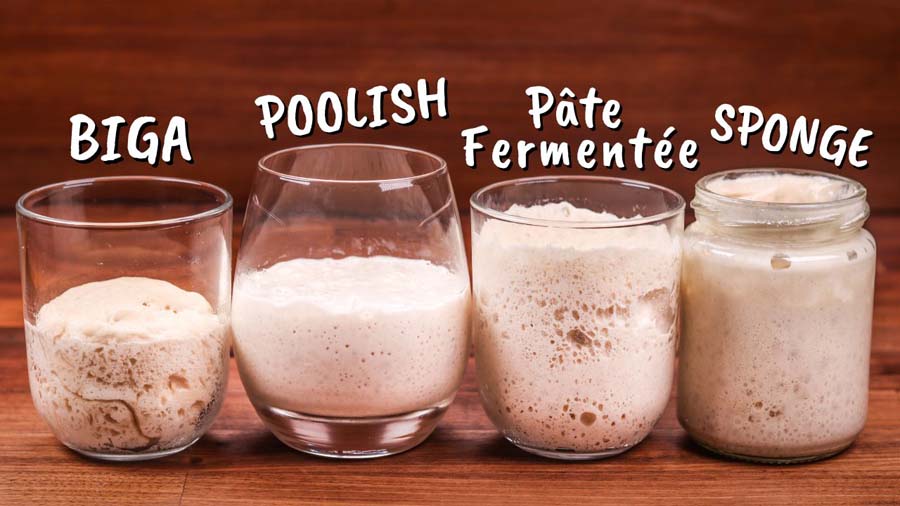One of the most viewed videos on my channel is about all the types of yeasted preferments and their uses.
I explained how they work and how to make them and in which breads they are mostly used. Ever since I started making comparison videos people have been asking me about how all the preferments would compare side-by-side in a regular loaf of bread.
Today we will find out. Of course, you will not be able to feel, taste, or smell the results, so this will be quite a subjective experiment. To really find out the difference you should try it yourself.
The preferments that we are testing are biga, poolish, pate fermentée, and sponge. Here is a detailed article covering all of them.
I made them all using an equal portion of the total flour of each recipe that being 50g (1.75oz). The biga, poolish, and pate fermentée were fermented for 12 hours and the sponge was fermented for just 1 hour since it is a quick preferment, and it contains all the yeast of the recipe.
The doughs had a hydration of 62% and were made with white bread flour.
All doughs were mixed and kneaded with their respective preferments added to them. Bulk fermentation took around 1.5 hours. Then a light pre-shaping was done with a quick 15-minute rest before the final shaping and the final proof which took 45 minutes.
Baked at 220C (F) the loaves came out of the oven after 30 minutes.
The resulting breads were extremely similar to each other. The slow fermented preferments loaves had just slightly more flavour than the one with made with the sponge. Their texture was almost the same too. Crumb structure was more open and irregular on the breads containing biga, poolish, and pate fermentée. While the sponge dough had a more even, smoother, and more tightly packed crumb.
There are of course different ways of looking at this. Some bakers do not add any more yeast to a dough that is made with a preferment. Instead, it is left to ferment for longer on the next day after the preferment is added. I almost always use more flour because I treat the preferment as a time saver. It adds enough flavour and changes the texture of the bread enough for me that I do not need to let it ferment for much longer.
If I had not added more yeast in this test, then I would expect similar results regardless. At least between the biga, poolish, and pate fermentée. If they all are made with the same percentage of total flour and as long as they are fermented for the same amount of time, they will produce the same result.
It is not important which preferment you use. The most important part is how you use and what you use it for.
If no more yeast is added, then why make a preferment at all? Simply ferment the whole dough for longer and skip the additional step of making a preferment.
A biga can be put to great use when your kitchen is warm as it ferments in a more controlled manner, and it does not break down as easily as a poolish. It can be fermented for longer developing more flavour which will improve the final loaf.
I like using poolish in winter because it can ferment slightly more rapidly, so it rises well in cooler temperatures.
Pate fermentée is just great for convenience if you bake bread every day. Depending on which kind of dough it is made from it could be left to ferment and ripen at room temperature or in the fridge for many hours or even days.
Sponge will always be a quick preferment. Use it when you don’t have time and you need to make the bread on that day. It adds just enough flavour to elevate the final loaf.
Biga, poolish, and pate fermentée can all be refrigerated to slow down fermentation and then used up to a whole day later. Since sponge contains all the yeast it would still over ferment.
You should try out all the preferments and see which one works best for you and the recipe. There is no such thing as the best preferment. It just depends on what you use it for and how you use it.
Watch the video here



